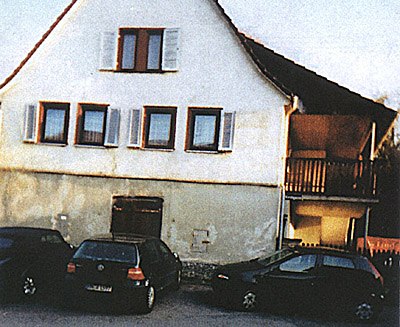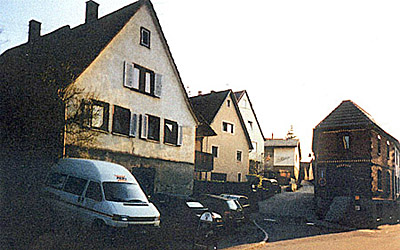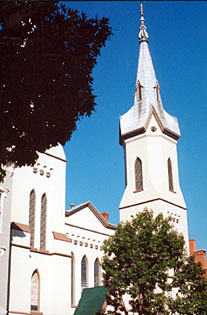

This property belonged to the Hohrien family until 1810.
(Photographs by Mr. Gerhard Munzing, 2004)

|

|
|
Boyhood home of Johann Tobias Horein in Flien, Germany This property belonged to the Hohrien family until 1810. (Photographs by Mr. Gerhard Munzing, 2004) |
| M.316 | Tobias and Elizabeth sold to Abraham Hedges and Joseph Hedges 10 acres, part of "Schin Talir Gutt", June 10, 1769. |
| M.368 | Tobias bought from John Johnson; James Flemming; Thomas Welch, the husband of Elizabeth, deceased; Ann and Hannah, daughters and co-heirs of John Johnson, late of Frederick County, 9 acres land and singular buildings, tract called "Knauss Disappointment", August 9, 1769 |
| M.596 | Bought from Thomas Johnson, Sr.* of Frederick County and Province of Maryland, part of tract called "Johnson's Delight" which was reduced into one entire tract called "Johnson's' Lain", containing 21 acres of land with all buildings, etc., November 28, 1769. There is no mention of Mary Johnson in this transaction. |
| N.592 | Bought from Thomas Johnson of Frederick County, two tracts or parcels of land; one called "Johnson's Lain", containing 81 acres of land; and also a part of the same tract called "Johnson's Lain" containing 25 acres of land, January 22, 1772. |
| P. 53 | At the request of Thomas Johnson the following deed was recorded December 25, 1771 to wit: This indenture made the 20th day of December 1771 between Tobias Horine of Frederick County of the one part and Thomas Johnson of the same county of the other part Witness that the said Tobias Horine sold unto the said Thomas Johnson a certain tract of land also a part of a tract called "Schin Talir Gutt" containing twenty acres of land also a part of a tract called "Johnson's Lain" containing eighty-one acres. No wife of Tobias Horine is mentioned in this deed. |

|
|
Evangelical Lutheran Church Frederick, Maryland |
| Page 102: | 2. Magdalena Elis. Haarnin, dau. of Tobias, born 2 February; baptized 2 June 1754; sponsor Magdalen., wife of Leonhard Hoffman. |
| Page 102 & 159: | 5. Johan Tobias Harein, son of Tobias and Elisabeth, born 15 January 1766; sponsor Tobias Reisner and wife Susanna. |
| Page 102: | 8. Elisabeth Haarein, dau. of Tobias and Elisabeth born 12 August, baptized 13 September 1771; sponsors, parents. |
Tobias HORINE deceased Michael TROUTMAN executor. 2/3 of 8 years rent of a still the widow having renounced the will of deceased claiming her thirds of rent. Sale of mill land.More About Johan Tobias Horein:
The Horine Family History is a compilation of information gathered over the past 60+ years by Mr. Paul G. Horine, Darla (Horine) Jones, John David Barrett, Eric T. Davis, Karen Montgomery, and many other contributors.
Horine Family History Home Page | Tree Outline of Horine Generations